When you think of guitar effects, one of the most recognisable would have to be the fuzz pedal.
Known for its saturated, woolly effect, the fuzz pedal has been a staple in may studios since its popularisation in the era of ’60s psychedelia.
It’s almost impossible to imagine Hendrix without his quintessential fuzz and wah duality.
For fans of big riffs, sonic unpredictability, and grunge, welcome to your ultimate fuzz pedal guide.
Compiled and edited by Emily Elvish
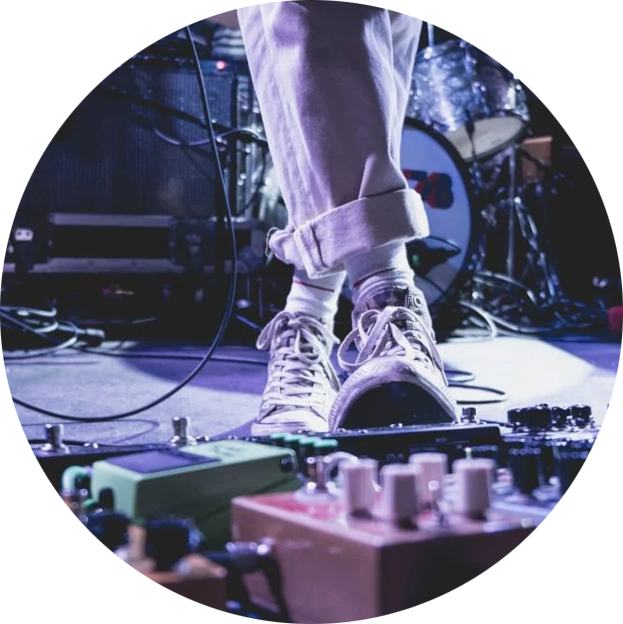
The best fuzz pedals
By Jack Foley
The art of fuzz has evolved massively over the decades and now there are more great options than ever. Let’s check out the best fuzz pedals you can get.
Many genres of music are unimaginable without the fuzz pedal. Beyond distortion and well beyond overdrive, the mighty fuzz has been an essential pedal for over half a century. After first emerging in the early 1960s, it was embraced by the psychedelic rock artists of that era. Since then the fuzz pedal has continued to excite guitar players for its rich sound and versatility.
The fuzz has consistently evolved as an effect as it’s been incorporated into myriad genres. So let’s check out 9 of the best fuzz pedals you can currently get your hands on, from those that pay homage to the traditional to some entirely fresh takes.
Electro-Harmonix Op-Amp Big Muff Reissue
The Big Muff is one of the most celebrated pedals ever made. In the fuzz pedal sphere, it is quite simply peerless. The Op-Amp Big Muff depends on op-amps rather than transistors, creating its unmistakably harmonically rich sizzle.
The Big Muff’s flexibility is the key to its enduring appeal. You can achieve both subtle and excessive levels of fuzz in equal measure. A timeless classic, you can’t go wrong.
To find out more visit Electro-Harmonix.
Death by Audio Supersonic Fuzz Gun
This pedal from Death by Audio can create some seriously gnarly sounds. It has five different controls, meaning it has more power than most fuzz pedals to shape your tone.
The extensive level of control is paired with a self signalling option that lets you create some truly strange and unpredictable sounds. This is the pedal that can go from the controlled to the extreme.
To find out more visit Death by Audio
Z.Vex Fuzz Factory
Created by American inventor Zach Vex in the mid-’90s, the Fuzz factory added some of the most significant adjustments to the fuzz pedal since its original invention. The most notable was the addition of feedback looping.
The Fuzz Factory is renowned for expanding the scope of tones possible in a single fuzz pedal, not to mention its striking hand-painted artwork. Definitely not your average fuzz pedal, but then again, none are on this list!
To find out more visit Z.Vex Effects
Electro-Harmonix Nano Big Muff
With the same circuitry as the original Big Muff, the Nano Big Muff packs the same amount of punch at a more pedalboard-friendly size. Electro-Harmonix themselves assures us that the Nano “works and sounds the same” as the original.
If you’ve already got a crowded pedalboard then this little guy is an ideal option. Another plus is that comes at a slightly cheaper price than the larger Big Muff models.
To find out more visit Electro-Harmonix.
Jim Dunlop FFM3 Jimi Hendrix Fuzz Face Mini
Jimi Hendrix was one the early high profile adopters of the fuzz pedals. The guitar legend’s enthusiasm for fuzz pedals undoubtedly had a major impact on its growth in popularity.
The Fuzz Face provides powerful mids-range cut through, giving the overall sound greater clarity. It also comes in a conveniently ‘Mini’ size — again, good if real estate is tight.
To find out more visit Dunlop.
Old Blood Noise Endeavors Haunt Fuzz
The Haunt Fuzz is Old Blood Noise Endeavors’ flagship pedal. So much so that its circuit technology is steeped in secrecy. Shhhh…
It can produce a broad range of sounds but it is best at creating harsh, extreme tones (perhaps explaining its name). If you want to take your fuzz tone to places that rarely explored then this is the pedal for you.
To find out more visit Old Blood Noise Endeavors.
Crazy Tube Circuits Constellation
This classy fuzz pedal was inspired by the classic fuzz pedals of the sixties. It actually includes NOS germanium CV7003 transistors from 1968 so it’s no wonder that the Constellation is reminiscent of this golden age.
It has a smart switching circuit that lets you choose between six different fuzz tones. Each pedal is individually hand-built and it’s obvious that quality was a priority. There have only been 200 made so if you want to get your hands on one then act fast.
To find out more visit Crazy Tube Circuits.
Joyo JF-12 Voodoo Octave
This super-affordable pedal from Joyo pairs also works as an octave shifting pedal, meaning you’re getting the power of two pedal devices for the price of one. Its octave shifting effects let you shift an octave upwards with a single switch.
It also sounds great as a standalone fuzz pedal with particularly strong saturated to fuzz tone. Having both effects which go together like peaches and cream in the same stompbox is bound to make many guitarists happy.
To find out more visit Joyo.
Jim Dunlop Way Huge Swollen Pickle Jumbo Fuzz MKIIS
The Way Huge Swollen Pickle from Jim Dunlop is undoubtedly one of the best fuzz pedals on the market. It offers an array of tonal options and a fantastically crisp sound —ideal for soaring lead lines.
The Way Huge Swollen Pickle is in the tradition of Big Muff styles fuzz pedals but with a bit more room for adjusting the overall EQ profile. Definitely an option worth considering for the tone connoisseurs out there.
To find out more visit Dunlop.
An idiot’s guide to choosing the right fuzz pedal
By Luka Osbourne
Are you an idiot? Check. Have you been looking to add some fuzz to your setup? Cool, say no more.
Most would consider fuzz to be the granddaddy of grit. It is one of the oldest and most endearing of all guitar effects, and also probably the simplest.
But don’t think for a second that they are easy to choose (and use).
There are surely a lot of options out there, from simple, vintage reissues to spiffy boutique boxes with more knobs and tones than your aunt’s new kitchen. Picking the right stompbox can mean the difference between getting lost in a mix, or cutting through with that heroic, creamy goodness.
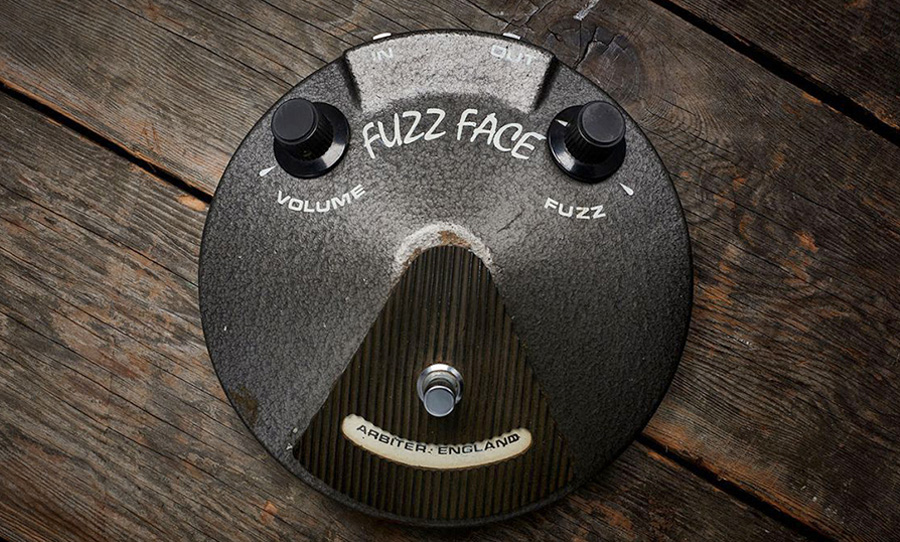
So What Is Fuzz?
Fuzz is well and truly its own thing. Although related, it’s in a different ballpark to overdrive and distortion. Overdrive is intended to be akin to a natural tube-driven amp, a warmer sound that gets hotter as the gain is cranked – using a cranked drive on an already hot amp can produce distortion. A distortion effect is overdrive’s angry step-brother, someone who just won’t behave at all and is always distorted at every volume level. Fuzz, well, let’s say it’s their mutant tripper cousin who basically flattens the whole signal to near a square wave while adding strange harmonics and overtones by multiplying all the freakiest of frequencies.
Of course, they get mixed up and there are overlaps, for instance, a well-behaved, dialled-back germanium fuzz can pass off as very warm overdrive and some of the more complex renditions of Big Muff circuitry certainly get very close to distortion. However, where drive and distortion can be pretty set in their ways, fuzz is more malleable and can be shaped by playing with amp settings, your guitar’s tone and volume dials and even the temperature of a room.
Originally born in the psychedelic ’60s, fuzz boxes have gone on to mingle with many genres, finding some use in blues (think Hendrix) alternative (i.e. Smashing Pumpkins), as well as shoegaze, experimental and noise – check out The Jesus and Mary Chain. It goes without saying that not all fuzzes are the same, and within the huge variety of incarnations, certain units will work better for different applications. Be sure to do your homework, spend some time listening to your favourites and work out where you wanna shoot in terms of tone.
A Little History…
The legendary Nashville Engineer, Glen Snoddy is credited as the inventor of the fuzz pedal. During a recording session with Marty Robbins, Snoddy noticed that bassist Grady Martin’s amplifier was creating a distorted ‘fuzzy’ sound, due to a blown preamp transformer. Rather than being bothered, Snoddy thought the strange noise was actually quite interesting, likening it to a baritone sax.
He set about trying to produce the sound for himself, entering a partnership with Gibson, and in 1962, the Maestro Fuzz-Tone FZ-1 was born. Maestro even released a promotional record to demonstrate how to use the Fuzz-Tone to create brass-like sounds with your guitar, so you could turn your guitar into a classical instrument! It was a nice idea but it didn’t exactly take off, however it found a bit of early love from The Ventures with their 1962 song 2000 Pound Bee.
You may not have heard of the Maestro but you’ve definitely heard it; the main riff of (I Can’t Get No) Satisfaction, that’s Keith playing the Fuzz-Tone, who acquired the then-new box while touring the US. The lick was actually a ‘holding track’ and the Stones originally intended to replace the raspy-brassy tone with an actual brass band, but they liked the new sound and it stuck. They weren’t the only ones who liked the sound, the single, as you may know, was a huge hit and immediately everyone wanted a slice of fuzz-pie. The Maestro sold out in 1965.
Until this point the Maestro wasn’t widely available in the UK, so a local company Sola Sound decided to give it a crack themselves, producing the now legendary Tonebender Mk1. This unit became hugely popular and was picked up by many musicians of the day, a good example being Jimmy Page’s work with the Yardbirds. The Dallas Arbiter Fuzz Face soon followed, a big round pedal that hit the scene with a smooth creamy fuzz, becoming legendary at the feet of none other than Jimi Hendrix.
These early pedals were things of simplicity, with only two knobs: volume and fuzz, however, artists often found ways to find a special sonic pocket by manipulating their guitars tone and volume knobs. Fuzz quickly became the sound of the 1960s and was adopted by just about all of the genres of rock at the time, from garage to blues. It eventually became a staple for heavier acts such as Led Zeppelin and Black Sabbath who pushed their fuzz boxes to the absolute limit.
By the end of the decade, most music manufacturers had their own fuzz, often based on the original circuitry, however, just in time for the 1970s, something completely different was born: the Big Muff Pi. Designed by Bell Labs engineer Bob Myer, the original ‘rams head’ Big Muff had three knobs for altering tone. The new fuzz was all about sustain, with artists like Santana and David Gilmour lapping it up for their lead playing.
Since these early days, various versions, remakes and replicas of these original circuits have been produced, from the mild-mannered to the wild and woolly.
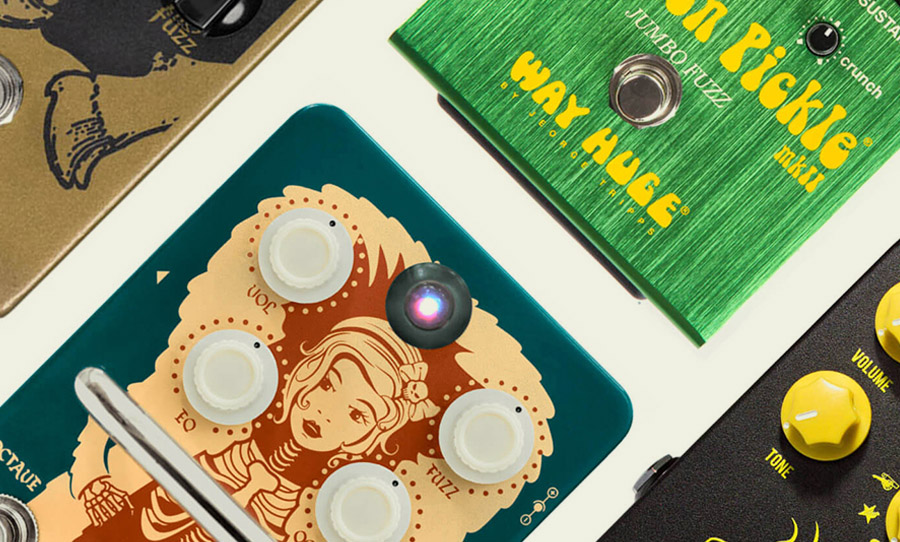
Fuzz Tones, Types and Transistors
As mentioned, most of the types of fuzz on the market today are based on a few original circuits. Although they are related, the subtle differences in circuitry arrangement, materials and transistors, can make huge differences in tone. As there have been hundreds of variants and clones of each fuzz circuit, this chapter will focus on the main fuzzes you will likely encounter.
The Maestro
The original fuzz was an angry box, aggressive in the trebles and generally a harsh sound. The overall voicing was brassy, almost saxophone-like, not surprising seeing as this was what Gibson-Maestro was going for. The Maestro wasn’t as heavy as some of the other fuzzes on this list, however, it suits vintage uses, particularly garage rock.
The Tone Bender
The Tone bender sounded very much like the Maestro, no surprise here as the former’s circuit was based on the latter’s. With each of the Tone Bender’s successive versions, it became more unique, and really defined the sound of Fuzz in the mid-1960s. The sound became warmer and more mid-heavy than the Maestro, however, it was more saturated and aggressive, with the ability to control this saturation with the guitars volume knob.
The Marshall Supa Fuzz
Based on the MK2 Tonebender, the Supa Fuzz had a boomy low end, with a lot of sustain, however, the pedal was not as saturated as some of its contemporaries. It was a continuing part of the Moody Blues guitarist Justin Hayward’s set up in the late 1960s and early 1970s.
The Fuzz Face
The quintessential fuzz. It was based on the Tone Bender circuit but had its own sound completely. A lot less saturated, it could be described as softer, warmer and rounder. The early germanium versions sound like a freaked-out overdrive and evoke the classic tones of Hendrix when used with a Stratocaster. The Fuzz Face and its many clones are known to be especially responsive to a guitars volume knob; by turning the knob down the sound cleans-up, while keeping a slight fizzy jangle that can be very inspiring to play with. Dunlop continues to produce the Fuzz Face in its original spec, however, countless companies have their own versions including, Analogman and Fulltone.
The Octavia
Something a little different, the Octavia was developed by Jimi Hendrix’s guitar tech Roger Mayer. It produced an upper octave sound when cranked, which was more pronounced higher up on the neck. The sound was quite aggressive and at times dissonant, as the octave was never quite pitch-perfect, however, it made for some warped and weird solo sounds, think Purple Haze or Fire.
The Univox Super-Fuzz
The Super-Fuzz was invented in 1968 by the Japanese company Shin-Ei, which later became Univox. This particular unit was one of the heaviest of all. A personal favourite of Pete Townsend’s, and later many 90s stoner-rock bands, the sound was incredibly saturated, with a lower octave and an upper octave, albeit quieter than the Octavia.
The Big Muff
Whereas all the above share DNA in their circuitry, the Big Muff is very different. Created in 1969 by Electro Harmonix, the sound was compressed, sustained and incredibly saturated, with two stages of distortion – in fact, many argue that it isn’t technically a fuzz but indeed a distortion. The beefy noise, however, was undoubtedly unique and unlike any modern distortions. It became a hit with hard rock acts in the 1970s and saw a resurgence in the 1990s with alternative artists favouring the op amp circuit and Russian-made varieties. Many variants have been produced, and Electro Harmonix continues to produce most of them today.
Big Muffs are typically scooped in the mid-range, however different variants of the circuit have given the unit their own unique EQ characteristics. The Big Muff has also been a favourite for boutique manufacturers to replicate, with many modern fuzzes being based or build around this circuit. Some examples are Way Huge’s Swollen Pickle, Skreddy Rusty Rod and Pete Cornish’s range of custom fuzzes.
Transistor Transition
Fuzzes created up until the end of the 1960s all used germanium transistors, which are characteristically warmer and smoother and hence sought after by pursuits for their vintage tone. One downfall, however, is the fact that germanium transistors are very sensitive and behave very differently at different temperatures.
Some say that cold temperatures treat them well, and rumour has it, that Jimi Hendrix would test out a stack of new Fuzz Faces, marking the best ones, only to find the sound change once he had taken them home. Silicon transistors became readily available towards the end of the decade; they were cheaper and offered more stability at different temperatures, as well as higher gain. Fuzz manufactures that continued into the 1970s, namely Dallas-Arbiter and Shin-Ei/Univox, were quick to lap up truckloads of the new parts.
The Silicon Fuzzface
Silicon Fuzzface was an entirely different beast to its Germanium brother. The initial silicon units used BC183 chips, with BC108s and BC109s eventually being substituted. These fuzzes often sounded crisper, more defined and less woofy than their germanium counterparts. With a lot more gain on tap, they helped to nurture the rise of a heavier guitar sound in rock and roll.
Some silicon models produced ridiculous amounts of fuzz, especially if the transistors were mismatched, and especially the later BC109 unit. These units were almost impossible to use with a wah-wah and were not for the faint-hearted, but with the right care, achieved aural perfection. The more punctual mid-top end allowed for artists to cut through with solos – that cracker on Pink Floyd’s Time? Thank the BC-108.
The Shin-Ei Companion Fuzz
This unit was a bit of a rarity, also making use of the new silicon transistors. Created by Shin-Ei in 1970, the unit was probably closer to a chainsaw than a fuzz. This unit was raspy and nasty and sounded, unlike any other fuzz box. It became a favourite for noise and experimental acts such as The Jesus and Mary Chain. As the sound is pretty niche, it is not the most sought-after effect, however, there are still some clones available produced such as Earthquaker Devices Terminal Fuzz.
The mid-1970s marked the beginning of overdrives, and more and more amplifiers were developed that had a drive channel (crazy I know). The sound of the day moved further away from the twisted sounds of fuzz, towards the sound of heavy amp saturation, and so the fuzz-box lay dormant in the popular consciousness. Fuzzes made a resurgence in the 1990s with grunge and alternative bands, which eventuated in a new interest, and many new manufacturers replicating, perfecting or modifying original circuits with modern practicalities.
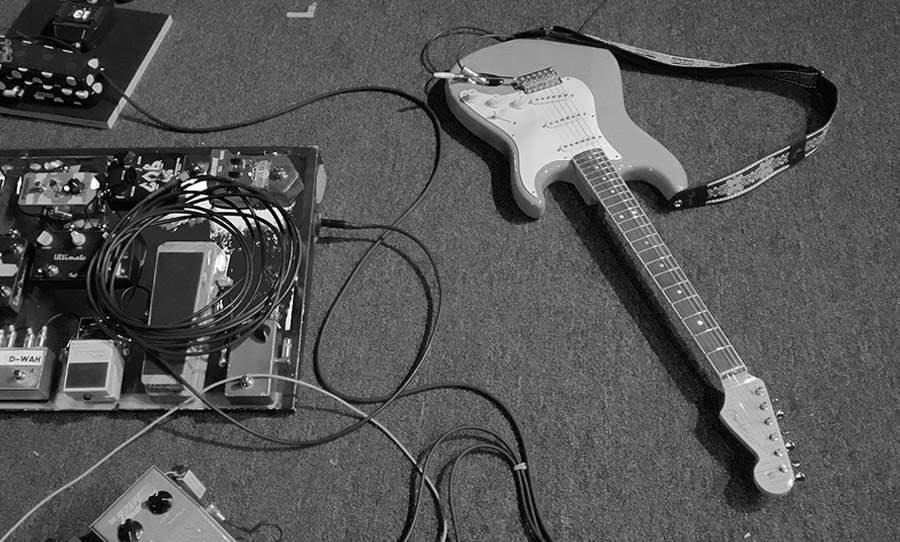
Don’t Be a knob
Unlike a lot of pedals, pulling any fuzz off a shelf and plugging it in won’t necessarily sound good. They take a bit of care to set up and sometimes require some special treatment. It won’t always work cranking everything to 11.
Gain/fuzz and volume
Gain/fuzz and volume are the only two knobs supplied on most vintage-style fuzz pedals. Most of the time these pedals sound best with the fuzz at or just before full bore, with the volume knob dialled to match the volume of the given situation, whether it be the rest of the band, or whatever is required in the studio.
Also, note that different varieties of fuzz will act differently in this department. The key here is pulling back on the guitars volume knob to find the sweet spot between definition and unbridled fuzzy goodness. Often this line is different depending on if a guitarist is playing rhythm or lead. Rhythm playing requires a good dialling back, keeping an extra couple of degrees on the knob for where it counts.
Tone
The tone control is a common addition and acts as a simple filter to accentuate highs, lows and or mids, depending on the circuit of the pedal. Dialling in some extra mids can help a fuzz pedal to cut through in a mix where it has the potential to be swamped. Some boutique fuzzes will have multiple tone controls for many different parameters, allowing you to really customise your tone. Some other names that may apply are body and balance.
Bias
Also called contour in some situations, bias is a common addition to modern fuzzes, particularly those with germanium transistors, as it can compensate for the effects of temperature variation. The function is to balance the texture of the fuzz as the saturation increases, the knob allowing a user to dial in woody-woofy-ness to a fizzy splattering mess. Whatever floats your boat.
Gate
Gate refers to a setting that tames the wild edge of the fuzz. It can be a built-in noise gate that can affect the supply voltage or the bias voltage within the fuzz pedal circuit, or a different circuit altogether. The function is to create a noise ceiling that allows sound to pass through at a certain volume. The result can create some wild stuttering effects, if that sounds nice to you take a look at the Zvex Wooly Mammoth or Fuzz Factory.
It seems every other day that manufacturers are inventing new parameters for crazy boutique fuzzes, and often they give the dial their own name, which can make it hard to make a comparison. Be sure to look out for stab or stability, which stabilises feedback, comp or compression, which squeezes the signal, and boost, which puts a few extra decibels up your sleeve for when you need it most.
Needless to say, the more knobs a pedal has, the harder it can be to find that sweet tone spot, sometimes simplicity truly is bliss.
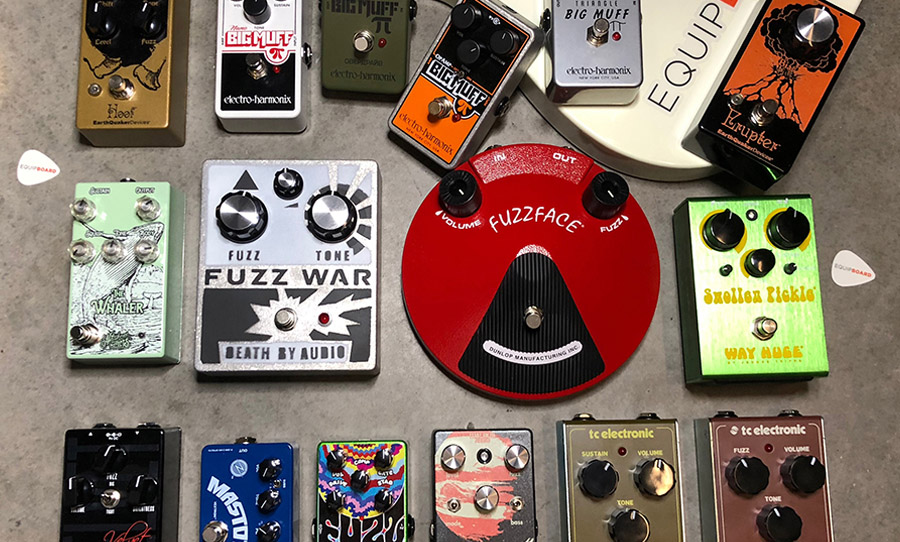
Taming the Fuzz
Other than twisting knobs, there are a few things to keep in mind when choosing a fuzz.
Amplifiers
Amps can make or break your tone. Getting an optimum sound often requires an amp that is driven or near breaking up, a little dirt that gives the fuzz something to dig into. If you crank that 100-watt combo and then stomp on a Big Muff, you’re not going to be popular in the neighbourhood, and you might need new windows. Different amps take pedals differently, and for most fuzzy situations starting with a smaller amp and getting it dirty is going to sound better than a big amp with miles of headroom.
Playability
You can’t just play every pedal the same way. Take a bit of time to think of how you’re going to use your fuzz. Will it be for lead or rhythm? A little accent here and there? Or blazing walls of sound? With all the crazy harmonics bouncing around, fuzzes can cause your progressions to lose definition. Do you have a 7th chord in there somewhere? Forget it, most fuzzes will sound whack with anything other than a power chord.
Take some time to audition pedals if possible, a good fuzz will respond to the dynamics of your playing, play soft and smooth and they’ll calm down, dig in and they will come alive. Also, I’m not sure if I’ve mentioned it enough, but make sure to see how the unit responds to your volume knob.
If your fuzz is for lead, look out for gain and sustain. Older vintage-style germanium pedals might be a bit underwhelming in this department, perhaps look at a Big Muff or a Silicon Fuzz, but be wary, if more gain means fizz then you won’t be heard at all. Boosting a fuzz with an overdrive such as a Tube Screamer is a common technique, which can add mid-range-beef without thinning out your signal. Muffs can be so thick that it’s possible to lose all definition when playing chords. If responsive rhythm is going to be your thing, maybe go for a germanium dialled back a little.
Power
Old fuzzes didn’t have DC inputs, they relied on batteries and many purists argue that this is the only way to power a Fuzz Face. Some even go as far as to only use half-charged batteries for particular tone properties. For most practical purposes (the audience won’t hear a god-damn difference) a 9-volt DC input is going to be more reliable and means you won’t have to worry about running out of juice mid-gig.
Placement
Fuzzes can get grumpy with a buffer behind them in the signal chain, especially older designs. Do you plan on using your fuzz with a wah? Not all fuzzes pair well with wah-wahs, especially silicon circuits as we already covered. If you think the positioning of your fuzz is going to be a problem, consider isolating it in a true-bypass loop.
So What Should I Get Then?
There are a lot of options and there is a lot to think about, so be sure to do your research before parting with your money – fuzzes can get dear for a small lump of steel and wires. Listen out for fuzz sounds that you like and try to determine whether that will fit your situation, whatever that may be. But do your own thing, no matter how much you want to sound like Hendrix, you probably won’t – his tone was in his fingers.
A pedal might sound great on Youtube demos, or in your bedroom, but then get lost as soon as you start playing with a band. See if your local will let you test some out, ask some friends if you can borrow theirs. Learn enough so you know what is what, but in the end, you won’t really know until you’ve done some road testing. The point here is to follow your ears, forget the musings of tone snobs, purists and the circuit obsessed, basically disregard this whole article and get out there and find a fuzz that works for you.
Sonic destruction and the apocalypse: a guide to naming a fuzz pedal
By Dan Shaw
How does one encapsulate the chaos that the fuzz can unleash on guitar tone? Such is the challenge that meets a maker when they are naming a fuzz pedal.
Born in the psychedelic ’60s, the fuzz came to the fore as the sound of distortion came of age. No longer satisfied with the soulful (or even accidental) over-saturation of guitar amp tubes, guitarists sought out fuzz pedals: dedicated devices for pushing the extremes of crunch.
Since then, the sound of fuzz has evolved and the monikers that various forms of fuzz have worn over the years stick in our minds. With the help of history and a couple of experts, we’re taking a look at how these stompboxes have earned such memorable labels, while simultaneously shedding light on the art of naming a fuzz pedal.
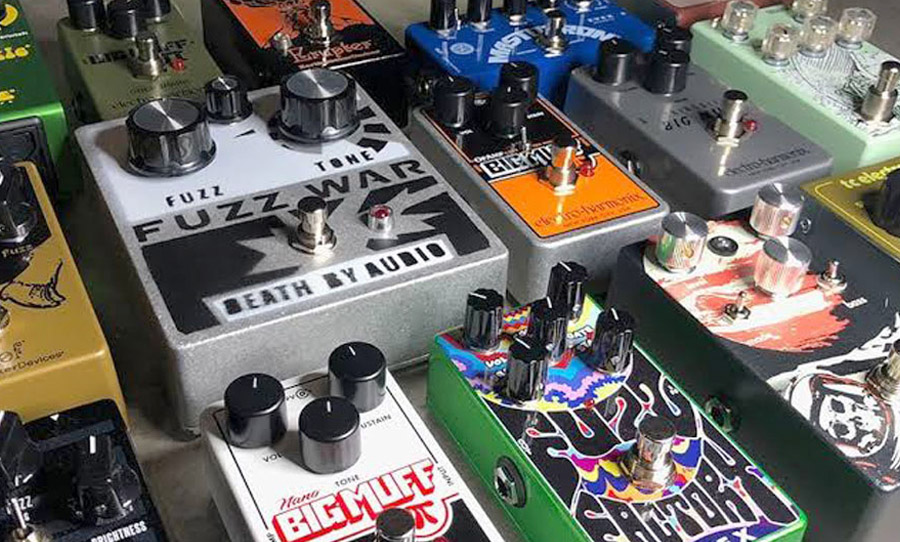
The Olden Days
The first fuzz pedal is credited to Glen Snoddy. He cut his teeth as a radio engineer in the army before becoming a fixture in the lauded Nashville studio scene, working alongside Johnny Cash, Hank Williams and Marty Robbins.
During a Marty Robbins session, he noticed a distorted tone coming from a bass amp and discovered that this was caused by a faulty component. He liked what he heard and set out to replicate it with a circuit built from scratch.
Gibson liked the result of Snoddy’s experiment so much that they sought to mass-produce this specialist device, which led to the birth of the Maestro Fuzz-Tone FZ-1 in 1962. This new-fangled device didn’t really achieve commercial success until it found the mother of all endorsements: the trademark riff from The Rolling Stones’ (I Can’t Get No) Satisfaction.
But Why ‘Fuzz’?
Yes, this pedal is rightly recognised as a way to destroy guitar tone and rebuild it in the form of gloriously over the top distortion. Yet originally, it wasn’t conceived as such.
Though orchestral and big band music was being swiftly swept aside by smaller ensembles, its influence could still be felt in the brave new era of rock and roll. So instead of being at the vanguard of teenage rebellion, Maestro’s Fuzz-Tone was marketed as a way to ape your favourite reed and brass sounds.
The sound of fuzz means has different stylistic implications today, but it is no less appropriate when applied to the rasping, distorted or ‘fuzzy’ tones created by clarinets, saxophones, trombones and more. This marketing tactic was mirrored in the beginnings of the Wah pedal – the first VOX Wah-Wah pedal’s signature artist was Clyde McCoy – a big band trumpeter who peaked in the 1930s.
It didn’t take long for the guitar to become the owner of the fuzz effect in its own right, giving up trying to be anything other than a glorious expression of heavy rock and psychedelia. This coincided with the release of the Big Muff Pi – the most famous fuzz in history and earning its name through its creator Mike Matthews’ description of its tone: “funky, soft, muffled sound.”
Aside from this rare departure, fuzz names have been relatively conservative for such a wild effect. In the early days, there was the Fuzz Face, Marshall’s Supa Fuzz, the Univox Super-Fuzz, the Shin-Ei Companion Fuzz. Understandably, mentioning fuzz in the title is pretty important if you want to sell the damn things.
Modern Masters
Nowadays, naming a fuzz pedal has become a more evocative exercise. New Zealand pedal maker Red Witch has invoked greek mythology with their Zeus Bass Fuzz Suboctave pedal – when you hear it, it’s hard to argue that you’re in the presence of the god of thunder.
With Hoof, Cloven Hoof and Erupter Earthquaker Devices have obviously plumbed the depths of the underworld to source their fuzz tone. Going a little further back, there’s the famous Way Huge Swollen Pickle – possibly a more confusing image, yet no less memorable.
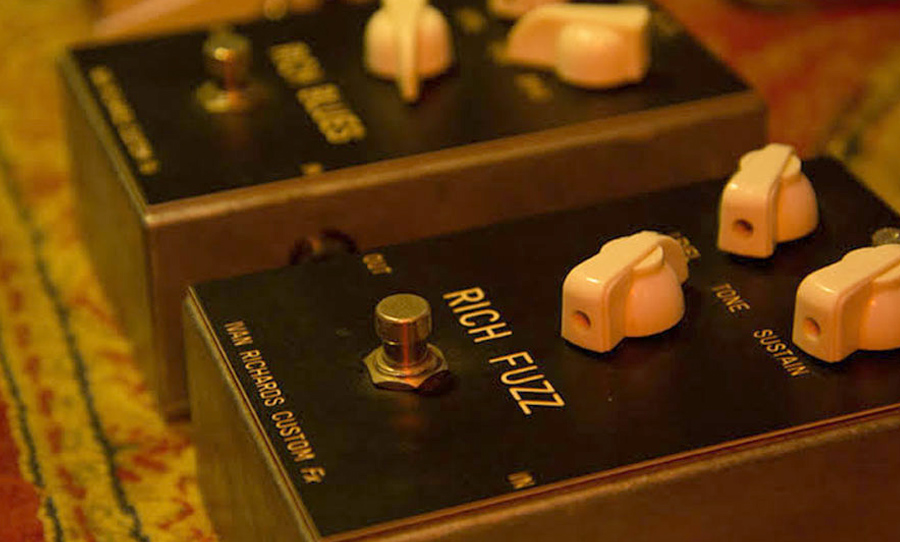
Local legend Ivan Richards of Ivan Richards Custom FX called his venerable version the Rich Fuzz. He’s the first to admit that his choice was rather prosaic, but he also declared:
“If I were to design a brand new fuzz in 2020, I would have to pick a name that was outrageous, provocative, risqué, possibly involving a double-entendre, and almost certainly not even mentioning the word fuzz.”
And all the way from New York, Death By Audio’s Oliver Ackermann weighs into the debate over naming a fuzz pedal:
“It needs to describe what the effect does – and what the pedal does should be annihilating the world and everyone around it into a total collapse of consciousness with no hope of ever getting back to reality. So maybe name the pedal The Collapse of Consciousness or No Hope for Reality.”
Bear in mind that this is a guy who is skilled in the art of naming a fuzz pedal. In the past, he’s bestowed the following names on his fuzz pedals: Supersonic Fuzz Gun, Fuzz War, Apocalypse and Absolute Destruction. If these names don’t bring the sonic mayhem of fuzz to mind, we don’t know what will.

So, how to apply these lessons to your own creation? Should you mention ‘fuzz’ in the title? Well, it’s worked pretty well so far for many varieties. Summoning beasts from the pits of hell, or incurring the wrath of mighty gods is also a strong theme.
Above all, naming a fuzz pedal is all about lighting fuzzy fires in a guitarist’s imagination, so whichever angle you choose, no matter how opaque or obvious, it better be epic.
The best fuzz pedals for bass
By Tim McArtney
As a bassist are you feeling left out with all this talk of fuzz and guitar married together? Stop those feels and join the fuzz club, here’s some excellent pedals you can drench your bass tone with!
We’re looking at exclusive bass fuzz pedals — and pedals to take you even lower than your band mates want — as these are made just for you and your instrument.
MXR Sub Octave Bass Fuzz
Not only does this pedal have bass written on it, this MXR Sub Octave Bass Fuzz comes with a Sub knob to take you and your bass lower — boot that kick drum outta your way. Sorry drummers!
It’s built for heavy and it’s built for bass all the while having two different fuzzes — take that guitarists! — with controls to burn and tweaking a plently.
With the ability to turn the octave on and off, this pedal wins as more ‘bang-for-your-buck’ as a first choice bassists fuzz. Synth bassists, please don’t feel left out as this pedal would pair very well with your analog bass patch.
Find out more at Jimdunlop.com
Electro-Harmonix Deluxe Bass Big Muff Pi Bass Fuzz Pedal
If you’ve ever plugged your bass into a Big Muff and felt like it fell short of what earth shattering low end would transpire — look no further, the good team at Electro-Harmonix have made this monster of a pedal, the Deluxe Bass Big Muff Pi Bass Fuzz Pedal.
Here’s a pedal that caters to the needs of bassists. You can blend so you don’t have to go full blown fuzz, change the tone, add sustain, use the inbuilt gate the stop the insane noise floor when you are not playing, attenuate the input and then there’s a HPF and LPF crossover to sculpt your sound.
As well as all these controls there’s an instrument jack direct out, a DI out and a crossover bypass button. See — not only guitarists get a plethora of controls.
Find out more at Electro-Harmonix.
The Trapper Dual Fuzz
Okay, this one doesn’t have bass written on it, but have you tried these Fender pedals that just snuck their way into the market? This particular pedal does wonders on a bass instrument.
The build of these pedals are solid as a rock, the LEDs and battery accessibility is very well thought out and the Trapper Dual Fuzz comes with an Octave switch — perfect for basses.
Much like the aforementioned MXR Sub Fuzz, the Trapper gives those low warm octaves with the option of going wild heavy or tamed heavy. If you dive into that contour control you’ll find a world of range to suit your taste.
While it doesn’t have the ins and outs like the other pedals, this one will fit way easier onto your pedal board and won’t drain your bank account either!
Do yourself a favour and check out more Fender pedals — they really are great pedals that many people have missed! Head over to Fender.com.


